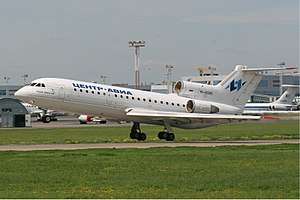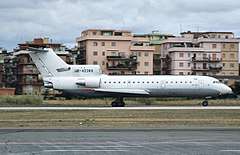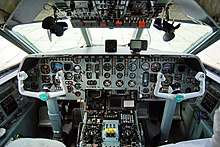Yakovlev Yak-42
The Yakovlev Yak-42 (Russian: Яковлев Як-42; NATO reporting name: "Clobber") is a 100/120-seat three-engined mid-range passenger jet. It was the first airliner produced in the Soviet Union to be powered by modern high-bypass turbofan engines.[2]
| Yak-42 | |
|---|---|
 | |
| Centre-Avia Yak-42D in 2006 | |
| Role | Narrow-body Jet airliner |
| Manufacturer | Saratov Aviation Plant |
| Design group | Yakovlev |
| First flight | 7 March 1975 |
| Introduction | 22 December 1980 |
| Status | In service |
| Primary users | Izhavia UTair Cargo KrasAvia Turukhan Airlines |
| Produced | 1979–2003 |
| Number built | 185[1] |
| Developed from | Yakovlev Yak-40 |
Design and development


In 1972, the Yakovlev design bureau started work on a short- to medium-range airliner capable of carrying 100–120 passengers. It was intended to be a replacement for the Tupolev Tu-134 jet as well as the Ilyushin Il-18, Antonov An-24 and An-26 turboprop airliners. While the new airliner was required to operate out of relatively small airfields while maintaining good economy, as many Soviet airports had been upgraded to accommodate more advanced aircraft, it did not have to have the same ability to operate from grass strips as Yakovlev's smaller Yak-40. The requirement resulted in the largest, heaviest and most powerful aircraft designed by Yakovlev,[3][4] until the even larger MC-21 took flight in 2017.
Initial design proposals included a straight-wing airliner powered by two Soloviev D-30 turbofans and resembling an enlarged Yak-40, but this was rejected as it was considered uncompetitive compared to Western airliners powered by high bypass ratio turbofans. Yakovlev settled on a design powered by three of the new Lotarev D-36 three-shaft high-bypass turbofans, which were to provide 63.90 kN (14,330 lbf) of thrust. Unlike the Yak-40, the new airliner would have swept wings.[4][5]
The Yak-42 is a low-winged monoplane of all-metal construction, with a design lifespan of 30,000 one-hour flights.[6] It has a pressurised fuselage of circular section, with the cabin designed to carry 120 passengers in six-abreast layout (or 100 passengers for local services with greater space allocated to carry-on luggage and coat stowage). The aircraft is flown by a flight crew of two pilots sitting side by side in a flight deck forward of the cabin. Access is via two airstairs, one in the underside of the rear fuselage, like that of the Yak-40, and one forward of the cabin on the port side. Two holds are located under the cabin, carrying baggage, cargo and mail.[7]
All of the prototypes had main landing gear with two wheels each, with the first serial production aircraft, four main wheels were introduced.[8] The wing layout underwent considerable revision during the design process, with the first prototype being built with a wing sweep of 11 degrees and the second prototype with a sweep of 23 degrees. After evaluation, the greater sweep of the second prototype was chosen for production. Early aircraft had a clean wing leading edge with no control surfaces, and plain trailing edge flaps. This changed in later aircraft, which were fitted with leading edge slats, with the trailing edge flaps slotted.[6][7][9]
Two engines were mounted in pods on either side of the rear fuselage, with the third embedded inside the rear fuselage, fed with air via an "S-duct" air inlet. An auxiliary power unit (APU) is also fitted in the rear fuselage. No thrust reversers are fitted. The aircraft has a T-tail, with both the vertical fin and the horizontal surfaces swept.[7]
Operational history
Testing
The first of three prototypes, which was fitted with an 11-degree wing and registered SSSR-1974, made its maiden flight on 7 March 1975. It was followed by the second prototype, (SSSR-1975) with the 23-degree wing and a cabin with 20 rows of windows instead of 17 in the first prototype, and a third prototype (SSSR-1976) fitted with improved de-icing gear.[9][10]
In service

The first production aircraft was completed on 28 April 1978, with the first scheduled passenger flight, on the Aeroflot Moscow-Krasnodar route taking place on 22 December 1980. Production was at first slow, with only 10 flown by mid-1981. Initial aircraft were fitted for 120 seats in a three-plus-three arrangement. This was soon changed to a first class section with two-plus-two seating, and a main cabin with 96 seats, giving a total of 104 seats.[11][12]
In its first year of operation Aeroflot's Yak-42s carried about 200,000 passengers, mainly on routes from Moscow, but also on international services from Leningrad to Helsinki and from Donetsk to Prague, with the type being planned to enter wider service throughout the Aeroflot fleet.[13] On 28 June 1982, however, the tailplane detached from an Aeroflot Yak-42 in flight owing to a failure of the actuator screw jack, causing the aircraft to crash fatally near Mazyr. The type was grounded as a result, not returning to service until October 1984.[14]
An export order for seven aircraft was announced in 1982 by Aviogenex of Yugoslavia, but the contract lapsed.[12] The availability of the longer-range Yak-42D variant from 1991 onwards gave rise to a few more export sales, to Bosnia, China, Cuba, and Iran. [15] As of 1 January 1995 a total of 185 Yak-42 had been produced, including 105 Yak-42Ds.[1]
Variants
- Yak-42
Original production version. Max. takeoff weight 54,000 kg (119,050 lb).[16]
- Yak-42ML
Version with modified avionics for use on international use (mezhdunarodnyye linii – international services). Entered service in July 1981 on the Leningrad-Helsinki route.[14]
- Yak-42D
Long-range version (Dahl'niy – long range) increased fuel. Replaced standard Yak-42 in production.[15]

- Yak-142
Derivative of Yak-42D with updated, western AlliedSignal avionics, spoilers to allow faster descent and enlarged cabin door to accommodate jet bridge. Also designated Yak-42A, Yak-42-100 and Yak-42D-100.[17]
- Yak-42R
Yak-42 used as testbed for radar for Yakovlev Yak-141 fighter.[1]
- Yak-42F
Conversion of a Yak-42 for geophysical survey and environmental monitoring. Fitted with large underwing pods containing electro-optical sensors.[18]
- Yak-42LL
Conversion as testbed for Progress D-236 propfan engine. Single D-236 (rated at 8,090 kW (10,850shp)) mounted in place of starboard engine, on special pylon to give sufficient clearance for 4.2 m (13 ft 9¾ in) propellers. First flew 15 March 1991.[1]
- Yak-42M
A projected but unbuilt stretched airliner. Planned to be powered by three Progress D-436 turbofans, a stretched fuselage and new wings. Design developed into Yak-242.[19]
- Yak-242
Further developed Yak-42M, with two underwing Aviadvigatel PS-90 turbofans. Design evolved into Irkut MC-21.[20]
Operators
As of July 2019, 22 Yak-42s remained in commercial airline service. Operators are Izhavia (8), KrasAvia (10) and Turuhan Aviacompany (4).[21]
Accidents and incidents
As of 15 February 2018, nine fatal Yak-42 accidents have occurred with a total of 570 casualties.
| Date | Tail number | Location | Casualties | Description | Refs |
|---|---|---|---|---|---|
| 28 June 1982 | SSSR-42529 | 132/132 | Aeroflot Flight 8641 lost control, entered a dive and broke apart in mid-air following failure of the jackscrew mechanism in the tail due to metal fatigue, caused by design flaws. All Yak-42s were grounded until the design defect was fixed. This is the deadliest Yak-42 crash, and the deadliest air crash in Belarus to date. | [22] | |
| 1986 | SSSR-42536 | 0 | The aircraft was being used for security forces training when a thunderflash ignited the interior. The aircraft burned out. | [23] | |
| 14 September 1990 | SSSR-42351 | 4/129 | Aeroflot Flight 8175 struck trees 1,700 m (5,600 ft) short of the runway and broke apart after the pilot intentionally deviated from the approach pattern during a late-night approach to Sverdlovsk inbound from Volgograd. | [24][25] | |
| 31 July 1992 | B-2755 | 108/126 | China General Aviation Flight 7552 climbed to 60 m (200 ft), lost control and crashed into a pond 600 m (2,000 ft) past the runway. | [26] | |
| 20 November 1993 | RA-42390 | 116/116 | Avioimpex Flight 110 struck a mountain near Ohrid in bad weather. The flight diverted to Ohrid due to heavy snowfall at its intended destination of Skopje. The aircraft was attempting a second approach when it crashed. Macedonian investigators stated that the cause was an inoperable VOR beacon and pilot error, while Russia stated that a misunderstanding from ATC had caused the accident. The aircraft was leased from Saravia. | [27] | |
| 17 December 1997 | UR-42334 | 70/70 | Aerosvit Flight 241 struck Mount Pente Pigadia due to pilot error. The flight missed the ILS approach and performed a go-around. The aircraft did not perform the ILS approach procedure, heading south-southwest instead of north, striking the mountain at 3,300 ft (1,000 m). | [28] | |
| 25 December 1999 | CU-T1285 | 22/22 | Cubana de Aviación Flight 310 struck a hill on approach after the pilot radioed that he was descending from 8,000 ft (2,400 m) to 4,000 ft (1,200 m). | [29] | |
| 26 May 2003 | UR-42352 | 75/75 | UM Airlines Flight 4230 struck a mountain in fog due to pilot error. 62 Spanish soldiers, members of the ISAF mission operating in Afghanistan, were among the dead. | [30] | |
| 7 September 2011 | RA-42434 | 44/45 | Yak-Service Flight 9633 en route to Minsk from Yaroslavl carrying the KHL Russian hockey team Lokomotiv Yaroslavl. The aircraft stalled and crashed on takeoff due to pilot error. | [31][32] |
Specifications (Yak-42D)
Data from Brassey's World Aircraft & Systems Directory 1999/2000.[16]
General characteristics
- Crew: 2 pilots plus optional flight engineer
- Capacity: up to 120 passengers (normally eight first class and 96 economy class)
- Length: 36.38 m (119 ft 4 in)
- Wingspan: 34.88 m (114 ft 5 in)
- Height: 9.83 m (32 ft 3 in)
- Wing area: 150 m2 (1,600 sq ft)
- Airfoil: root: TsAGI SR-9 (8.5%) ; tip: TsAGI SR-9 (6.5%)[33]
- Empty weight: 33,000 kg (72,753 lb)
- Max takeoff weight: 57,500 kg (126,766 lb)
- Powerplant: 3 × Lotarev D-36 turbofan engines, 63.75 kN (14,330 lbf) thrust each
Performance
- Maximum speed: 810 km/h (500 mph, 440 kn)
- Cruise speed: 740 km/h (460 mph, 400 kn)
- Range: 4,000 km (2,500 mi, 2,200 nmi)
- Service ceiling: 9,600 m (31,500 ft)
See also
Related development
Aircraft of comparable role, configuration and era
Related lists
References
- Gunston and Gordon 1997, p. 198.
- Gunston, 1997
- Gordon, Komissarov and Komissarov 2005, p. 311.
- Gunston and Gordon 1997, p. 194.
- Gordon, Komissarov and Komissarov 2005, pp. 311–312.
- Gunston and Gordon 1997, p. 195.
- Taylor 1982, p. 241.
- OKB Yakovlev: A History of the Design Bureau and Its Aircraft von Yefim Gordon (Author), Dmitriy Komissarov (Author), Sergey Komissarov (Author) ISBN 1-85780-203-9 ISBN 978-1-85780-203-0
- Gordon, Komissarov and Komissarov 2005, pp. 312–314.
- Gunston and Gordon pp. 196–197.
- Gordon, Komissarov and Komissarov 2005, pp. 314–315.
- Gunston and Gordon 1997, p. 197.
- Flight International 30 January 1982, p. 208.
- Gordon, Komissarov and Komissarov 2005, p. 315.
- Gordon, Komissarov and Komissarov 2005, p. 316.
- Taylor 1999, pp. 227–228.
- Gordon, Komissarov and Komissarov 2005, pp. 317–318.
- Gordon, Komissarov and Komissarov 2005, p. 318.
- Gordon, Komissarov and Komissarov 2005, pp. 319–320.
- Gordon, Komissarov and Komissarov 2005, pp. 320–321.
- Thisdell and Seymour Flight International 30 July–5 August 2019, p. 47.
- Accident description for SSSR-42529 at the Aviation Safety Network. Retrieved on 2016-02-02.
- Accident description for SSSR-42536 at the Aviation Safety Network. Retrieved on 2016-02-02.
- "Yak-42 crashes". CBC. Archived from the original on 16 January 2014. Retrieved 15 January 2014.
- Accident description for SSSR-42351 at the Aviation Safety Network. Retrieved on 2016-02-02.
- Accident description for B-2755 at the Aviation Safety Network. Retrieved on 2016-02-02.
- Accident description for RA-42390 at the Aviation Safety Network. Retrieved on 2016-02-02.
- Accident description for UR-42334 at the Aviation Safety Network. Retrieved on 2016-02-02.
- Accident description for CU-T1285 at the Aviation Safety Network. Retrieved on 2016-02-02.
- Accident description for UR-42352 at the Aviation Safety Network. Retrieved on 2016-02-02.
- "Top KHL squad killed in passenger plane crash in Russia". RT News. Archived from the original on 8 September 2011. Retrieved 7 September 2011.
- Accident description for RA-42434 at the Aviation Safety Network. Retrieved on 2016-02-02.
- Lednicer, David. "The Incomplete Guide to Airfoil Usage". m-selig.ae.illinois.edu. Retrieved 16 April 2019.
- "Aeroflot completes one year of Yak-42 operations". Flight International, 30 January 1982. p. 208.
- Gordon, Yefim, Dmitry Komissarov and Sergey Komissarov. OKB Yakovlev: A History of the Design Bureau and its Aircraft. Hinkley, UK: Midland Publishing, 2005. ISBN 1-85780-203-9.
- Gunston, Bill and Yefim Gordon. Yakovlev Aircraft since 1924. London, UK: Putnam Aeronautical Books, 1997. ISBN 1-55750-978-6.
- Taylor, Joihn W. R. Jane's All The World's Aircraft 1982–83. London: Jane's Yearbooks, 1982. ISBN 0-7106-0748-2.
- Taylor, Michael J. H. Brassey's World Aircraft & Systems Directory 1999/2000. London: Brassey's, 1999. ISBN 1-85753-245-7.
- Thisdell, Dan and Morris, Rob. "World Airliner Census". Flight International, Vol. 194, No. 5650, 21 August–3 September 2018. ISSN 0015-3710. pp. 24–47.
- Thisdell, Dan and Seymour, Chris. "World Airliner Census". Flight International, Vol. 196, No. 5694, 30 July–5 August 2019. ISSN 0015-3710. pp. 24–47.
External links
| Wikimedia Commons has media related to Yakovlev Yak-42. |